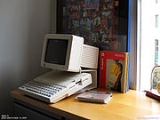
Snow White design language
Encyclopedia
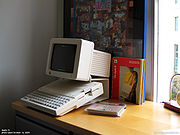
Design language
A design language or design vocabulary is an overarching scheme or style that guides the design of a complement of products or architectural settings...
developed by Hartmut Esslinger
Hartmut Esslinger
Hartmut Esslinger is a German-American industrial designer and inventor. He is known for his design company Frogdesign, particularly his work for Apple Computer in the 1980s.-Life and career:...
's Frog Design
Frog design inc.
Frog is a global innovation firm founded in 1969 by industrial designer Hartmut Esslinger and partners Andreas Haug and Georg Spreng in Mutlangen, Germany as "Esslinger Design". Soon after it moved to Altensteig, Germany, and then to Palo Alto, California, and ultimately to its current...
. Used by Apple Computer
Apple Computer
Apple Inc. is an American multinational corporation that designs and markets consumer electronics, computer software, and personal computers. The company's best-known hardware products include the Macintosh line of computers, the iPod, the iPhone and the iPad...
from 1984 to 1990, the scheme has vertical and horizontal stripe
Stripe
Stripe or Stripes may refer to:* Stripes * Stripes * S.T.R.I.P.E., a fictional superhero* Striper, a fish* Stripes Convenience Stores* Data striping, a data storage technique...
s for decoration, ventilation
Ventilation (architecture)
Ventilating is the process of "changing" or replacing air in any space to provide high indoor air quality...
, and the illusion
Optical illusion
An optical illusion is characterized by visually perceived images that differ from objective reality. The information gathered by the eye is processed in the brain to give a perception that does not tally with a physical measurement of the stimulus source...
that the computer enclosure is smaller than it actually is.
The design language boosted Apple’s global reputation, set design trends for the computer industry, and molded the perception of computers in the manufacturing and business world.
Among other design features, Esslinger's presentation of the Apple logo—a three-dimensional logo inlaid into the product case with the product name printed onto its surface—was included on nearly every product for several years.
History
In 1982, Apple officials looked outside the company and indeed the country for a designer who could help them establish the firm as a world-class company.Snow White refers to the seven projects code-named after the Seven Dwarves on which the new design language was to be applied. Several designers were courted by Apple under the Snow White project to see what they would come up with for the seven products (of which there were actually eight). The winner ultimately was Esslinger and the resulting style assumed the project’s code name.
The Apple IIc
Apple IIc
The Apple IIc, the fourth model in the Apple II series of personal computers, was Apple Computer’s first endeavor to produce a portable computer. The end result was a notebook-sized version of the Apple II that could be transported from place to place...
computer, and its peripherals, were the first Snow White design.
Initially, Snow White debuted in a creamy off-white
Cream (colour)
Cream is the colour of the cream produced by cattle grazing on natural pasture with plants rich in yellow carotenoid pigments, some of which are incorporated into the cream, to give a yellow tone to white. Cream is the pastel colour of yellow, much like as pink is to red. Cream is used as a skin...
color known at Apple as “Fog” but later other products moved to the warm gray “Platinum” color, lighter than the previous Apple “Putty
Beige box
In consumer computer products, a beige box is a standard personal computer . It has come to be used as a term of derision implying conservative or dated aesthetics and unremarkable specifications....
” color, used throughout the Apple product line from 1987 on. Esslinger favored a bright-white color originally for the IIc, but Jerry Manock
Jerry Manock
Jerrold C. Manock is an American industrial designer. He worked for Apple Computer from 1977 to 1984, contributing to housing designs for the Apple II, Apple III, and earlier compact Apple Macintosh computers. Manock is widely regarded as the "father" of the Apple Industrial Design Group...
successfully argued that it would attract fingerprints. Nevertheless, Esslinger detested the original Apple beige-color and insisted all Snow White-styled products use the same off-white color as the IIc. Until the change to Platinum, no Snow White designs appeared in any other color, except for the Hard Disk 20SC
Hard Disk 20SC
The Apple Hard Disk 20SC was Apple's first SCSI based hard drive for the Apple II family as well as the Macintosh and other third party computers using an industry standard SCSI interface.-History:Released...
in order to better match the beige color of the Macintosh Plus
Macintosh Plus
The Macintosh Plus computer was the third model in the Macintosh line, introduced on January 16, 1986, two years after the original Macintosh and a little more than a year after the Macintosh 512K, with a price tag of US$2599...
beneath which it was designed to sit.
The Snow White language was gradually phased out after 1990 as it was adapted by the Apple Industrial Design Group
Apple Industrial Design Group
The Apple Industrial Design Group is the industrial design arm of Apple Inc. responsible for crafting the appearance of all Apple products, including the Apple Macintosh computer line.-History:...
.
Design features
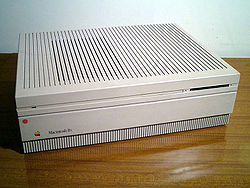
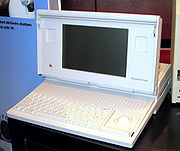
- minimal surface texturing
- colored a light off-white (Fog) or light gray (Platinum)
- inlaid three-dimensional Apple logo, diamond cut to the exact shape
- zero-draft enclosures, with no variances in case thickness and perpendicular walls
- recessed international port identification icons
- silk-screened product name badging
- shallow horizontal and vertical lines, 2 mm wide, 2 mm deep, spaced 10 mm apart on center, which run along any and all of the surfaces of the product, some of which act as vents and setback 30 mm from the front and 4 mm from the back.
- Fog products have beige accents and cables, Platinum products have uniform color (no accents) and Smoke gray cables
- 3mm radius, rear and 2mm radius, front corners
- simple unadorned ports and slots
Any or all of these features indicate a Snow White Frog Design influence over an otherwise Apple designed product. In particular the first official implementation, the Apple IIc
Apple IIc
The Apple IIc, the fourth model in the Apple II series of personal computers, was Apple Computer’s first endeavor to produce a portable computer. The end result was a notebook-sized version of the Apple II that could be transported from place to place...
does not represent the complete set of design elements, while the Macintosh II
Macintosh II
The Apple Macintosh II was the first personal computer model of the Macintosh II series in the Apple Macintosh line and the first Macintosh to support a color display.- History :...
includes all of them. Later, the Macintosh LC
Macintosh LC
The Macintosh LC was Apple Computer's product family of low-end consumer Macintosh personal computers in the early 1990s. The original Macintosh LC was released in 1990 and was the first affordable color-capable Macintosh. Due to its affordability and Apple II compatibility the LC was adopted...
began to phase out some of the design elements.

Implementation
Apple products designed in the Snow White theme (all used the “Platinum” gray color scheme except as noted):
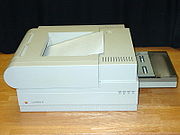
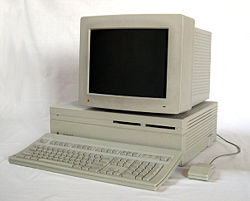
- Apple IIcApple IIcThe Apple IIc, the fourth model in the Apple II series of personal computers, was Apple Computer’s first endeavor to produce a portable computer. The end result was a notebook-sized version of the Apple II that could be transported from place to place...
(1984) - Disk IIc (1984)
- Apple Scribe PrinterApple Scribe PrinterThe Apple Scribe Printer was a thermal transfer printer made by Apple and first introduced in 1984 alongside the Apple IIc for a relatively low retail price of $299. It was a thermal printer, but was a significant advancement over the old Silentype. It could print on regular paper , and could print...
(1984) - Apple Mouse IIc (1984)
- AppleTalk Connector FamilyLocalTalkLocalTalk is a particular implementation of the physical layer of the AppleTalk networking system from Apple Computer. LocalTalk specifies a system of shielded twisted pair cabling, plugged into self-terminating transceivers, running at a rate of 230.4 kbit/s...
(1985) - LaserWriterLaserWriterThe LaserWriter was a laser printer with built-in PostScript interpreter introduced by Apple in 1985. It was one of the first laser printers available to the mass market...
(1985) - ImageWriter II (1985)
- Apple Personal Modem (1985)
- Apple UniDisk 3.5 (1985)
- LaserWriter Plus (1986)
- Apple IIGSApple IIGSThe Apple , the fifth and most powerful model in the Apple II series of personal computers produced by Apple Computer. The "GS" in the name stands for Graphics and Sound, referring to its enhanced graphics and sound capabilities, both of which greatly surpassed previous models of the line...
(1986) - Apple 3.5 Drive (1986)
- Hard Disk 20SCHard Disk 20SCThe Apple Hard Disk 20SC was Apple's first SCSI based hard drive for the Apple II family as well as the Macintosh and other third party computers using an industry standard SCSI interface.-History:Released...
(1986) - Macintosh SEMacintosh SEThe Macintosh SE was a personal computer manufactured by Apple between March 1987 and October 1990. This computer marked a significant improvement on the Macintosh Plus design and was introduced by Apple at the same time as the Macintosh II....
series (1987) - Macintosh IIMacintosh II seriesThe Macintosh II series was a series of personal computers in Apple's Macintosh line.-Features:Unlike prior Macintosh models, which were all compact Macintosh designs, the Macintosh II models were "modular" systems which did not include built-in monitors and were expandable...
(1987) - ImageWriter LQ (1987)
- Apple PC 5.25 Drive (1987)
- AppleFax Modem (1987)
- Macintosh IIxMacintosh IIxThe Macintosh IIx was introduced by Apple in 1988 as an incremental update of the original Macintosh II model. It replaced the 16 MHz Motorola 68020 CPU and 68881 FPU of the II with a 68030 CPU and 68882 FPU ; and the 800 KB floppy drive with the 1.44 MB SuperDrive...
(1988) - Apple IIc PlusApple IIc PlusThe Apple IIc Plus is the sixth and final model in the Apple II line of personal computers, produced by Apple Computer. The "Plus" in the name was a reference to the additional features it offered over the original portable Apple IIc, such as greater storage capacity , increased processing speed,...
(1988) - LaserWriter II (1988)
- AppleCD SC (1988)
- Apple ScannerApple ScannerIn August 1988 Apple introduced the Apple Scanner. It was their first A4 flatbed scanner. It was capable of a 4-bit image with 16 levels of grey in a maximum resolution of 300 dpi. The scanner could complete a full scan in 20.4 seconds...
(1988) - Apple FDHD External DriveSuperDriveSuperDrive is a trademark used by Apple Inc. for two different storage drives: from 1988–99 to refer to a high-density floppy disk drive capable of reading all major 3.5" disk formats; and from 2001 onwards to refer to a combined CD/DVD reader/writer....
(1988) - Macintosh PortableMacintosh PortableThe Macintosh Portable was Apple Inc.'s first attempt at making a battery-powered portable Macintosh personal computer that held the power of a desktop Macintosh...
(1989) - Macintosh IIfxMacintosh IIfxThe Macintosh IIfx was a model of Apple Macintosh computer, introduced in 1990 and discontinued in 1992. At introduction it cost from US $9,000 to US $12,000, depending on configuration, and was the fastest Mac...
(1990)
- a:^ While the IIc generally gets credit for being the first Apple computer released in the Snow White design language, it was not a “pure” example. Rob Gemmel (who was instrumental in soliciting Esslinger) had designed the IIc a year earlier and unbeknownst to him, Frog Design was working on their own design. In the end it was a compromise of Gemmel’s original design and Frog Design’s modifications. Likewise, the Macintosh SE was essentially Manock and Oyama’s design updated with Snow White details. The IIgs, which introduced Platinum gray, also evidenced the legacy design of the original Apple II case, in particular Manock’s wedge-shape. It wasn’t until the Macintosh II when Frog Design finally had a clean slate on which to design from the ground up, that the first pure example of pure Snow White was realized.
- b:^ Introduced in off-white “Fog” and later switched to “Platinum” gray
- c:^ Off-white “Fog” only
- d:^ Introduced simultaneously in both Apple/Macintosh beige and “Platinum” gray to better match the beige Macintosh PlusMacintosh PlusThe Macintosh Plus computer was the third model in the Macintosh line, introduced on January 16, 1986, two years after the original Macintosh and a little more than a year after the Macintosh 512K, with a price tag of US$2599...
for which it was designed to sit beneath as well as conform to the Apple IIgs color scheme released at the same time. This would be the only Snow White product to intentionally use the original beige color for the purpose of matching existing products.
- e:^ All Apple connectors and cables began a transition to beige in 1985, however, certain Macintosh peripheral cables (e.g. mice and disk drives), despite adopting the new connector style, retained their medium-brown appearance until the transition to Platinum in 1987, at which time all cables became a dark gray color Apple called “Smoke.”
- f:^ Though technically beige, like the connectors & cables, the Mouse //c is considered to be colored as a Fog co-ordinated accent. It is definitely a Snow White design, which elements form the basis for the subsequent Apple Desktop Bus Mouse. It was not produced in Platinum.
Most Apple Displays
Apple displays
Apple Inc. currently sells LCD computer displays; a wide variety of CRT computer displays have been sold in the past.- CRT displays :In the very beginning , Apple did not manufacture or sell displays of any kind, instead recommending users plug-into their television sets or expensive third party...
introduced between 1984 and 1994 also used Snow White, except those specifically designed to match the Apple II
Apple II
The Apple II is an 8-bit home computer, one of the first highly successful mass-produced microcomputer products, designed primarily by Steve Wozniak, manufactured by Apple Computer and introduced in 1977...
series.
All Apple ADB keyboards and mice introduced between 1986 and 1993 were Snow White designs.
Unofficial Designs
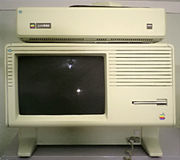
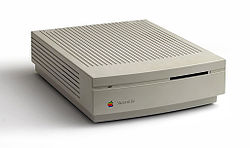

- The Lisa 2Apple LisaThe Apple Lisa—also known as the Lisa—is a :personal computer designed by Apple Computer, Inc. during the early 1980s....
/Macintosh XLMacintosh XLMacintosh XL was a modified version of the Apple Lisa personal computer made by Apple Computer, Inc. In the Macintosh XL configuration, the computer shipped with MacWorks XL, a Lisa program that allowed 64 K Macintosh ROM emulation...
(1984) had Snow White stripes added to the front bezel redesign along with the inlaid Apple badging four months before the Apple //c was introduced, technically making it the first Snow White product. - The Apple Modem 300/1200 (1985) was updated from Apple beige to Fog and the inlaid Apple badging was added.
- The Macintosh PlusMacintosh PlusThe Macintosh Plus computer was the third model in the Macintosh line, introduced on January 16, 1986, two years after the original Macintosh and a little more than a year after the Macintosh 512K, with a price tag of US$2599...
(1986) was updated by Frog Design, but only added the inlaid Apple badging and recessed connector icons. - The Macintosh 800K External Drive (1986) only included the inlaid Apple badging and simple floppy disk slot styling as well as the 2 and 3 mm radius corners and zero draft enclosure.
- The Macintosh IIcxMacintosh IIcxHalf a year following the release of the Macintosh IIx passed before Apple introduced the Macintosh IIcx in 1989. Despite resembling the IIx to a great extent and providing the same performance, the IIcx was quieter than its predecessor. The design was also made much more compact by reducing the...
(1989) was designed in-house entirely by Apple and though drawing upon the Snow White corporate language, departed considerably from the guidelines. This was the beginning of Apple’s efforts to break ties with Frog Design and rebuild the Industrial Design Group. - The Macintosh IIciMacintosh IIciThe Apple Macintosh IIci was an improvement on the Macintosh IIcx. Sharing the same compact case design with three expansion slots, the IIci improved upon the IIcx's 16 MHz Motorola 68030 CPU and 68882 FPU, replacing them with 25 MHz versions of these chips. The IIci came with either a 40 or...
(1989) basically the same case as the IIcx with different internal hardware. - Macintosh LCMacintosh LCThe Macintosh LC was Apple Computer's product family of low-end consumer Macintosh personal computers in the early 1990s. The original Macintosh LC was released in 1990 and was the first affordable color-capable Macintosh. Due to its affordability and Apple II compatibility the LC was adopted...
(1990) - Macintosh LC II (1992)
- Macintosh Quadra 700Macintosh Quadra 700The Macintosh Quadra 700 was introduced along with the Quadra 900 in October 1991 as Apple's first computers to use the Motorola 68040 processor, as well as the first to feature built-in Ethernet networking as many Unix workstations did...
(1991) - PowerBook 100/200 Series (1991)
- Macintosh Quadra 900Macintosh Quadra 900The Macintosh Quadra 900 was a high-end personal computer introduced with the Quadra 700 in October 1991 as Apple Computer's first computers in the Quadra series using the Motorola 68040 processor. It was discontinued in 1992, and succeeded by the very similar Quadra 950. The Quadra 900 was more...
(1991) - Macintosh Quadra 950Macintosh Quadra 950The Macintosh Quadra 950 was the third desktop computer in Apple Computer's Quadra line. It was based on Motorola's 68040 microprocessor rather than the 68LC040 . It replaced the Quadra 900, increasing the CPU clock rate from 25 MHz to 33 MHz, and improving the graphics support...
(1992) - PowerBook Duo Dock (1992)
- Macintosh LC II (1992)
- Macintosh IIsiMacintosh IIsiThe Macintosh IIsi was a compact three-box desktop unit, effectively a cut-down Macintosh IIci in a smaller case , made cheaper by the redesign of the motherboard and the deletion of all but one of the expansion card slots...
(1993) - Macintosh LC III (1993)
- Macintosh LC III+ (1993)
- Macintosh LC 475 (1993)
- Apple Workgroup ServerApple Workgroup ServerApple Workgroup Server and, later, Macintosh Server, were the names given to selected models of Macintosh computers which were sold by Apple Computer with additional server software and sometimes bigger hard drives. Apart from that, they were mostly identical to computers out of Apple's...
95 (1993) - Apple Workgroup Server 9150Workgroup Server 9150The Apple Workgroup Server 9150 is the only Apple Workgroup Server model not based on a desktop Mac. It featured an 80 MHz PowerPC 601 board in a Quadra 950 style case . The internal bay of the 950 case was filled with a tape backup drive. It has 8MB of RAM . It runs System 7.5 to Mac OS 9.1....
(1994)
Both the 100 and 200 series PowerBooks and accessories were intended to tie into the rest of the Apple desktop products utilizing the corporate Snow White design language. However, the light colors and decorative recessed lines did not seem appropriate for the scaled down designs. In addition to adopting the darker grey colour scheme which co-ordinated with the official corporate look, they also adopted a raised series of ridges mimicking the indented lines on the desktops. These early PowerBooks would be the last to utilize the aging Snow White look and the only ones to make such a radical adaptation of it.
See also
- Timeline of Macintosh models
- List of products discontinued by Apple Inc.

